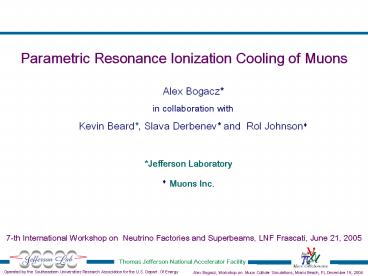Berkeley Lab Generic Presentation - PowerPoint PPT Presentation
Title:
Berkeley Lab Generic Presentation
Description:
Chromatic aberrations - compensation of the detuning effects with RF. tracking studies ... Chromatic aberration compensation with RF cells 1-4 ... – PowerPoint PPT presentation
Number of Views:22
Avg rating:3.0/5.0
Title: Berkeley Lab Generic Presentation
1
Parametric Resonance Ionization Cooling of Muons
Alex Bogacz in collaboration with Kevin Beard,
Slava Derbenev and Rol Johnson?
Jefferson Laboratory ? Muons Inc.
7-th International Workshop on Neutrino
Factories and Superbeams, LNF Frascati, June 21,
2005
2
Overview
- Final transverse ionization cooling - Parametric
resonance enhancement - Resonant transport channels - lattice prototypes
- quadrupole based
- solenoid based
- Transverse beam dynamics in the cooling channel
tracking studies - soft-edge solenoid
- linear transfer matrix
- nonlinear corrections (in tracking)
- thin ideal absorber model
- Chromatic aberrations - compensation of the
detuning effects with RF - tracking studies
3
Transverse parametric resonance cooling
- Transport channel (between consecutive absorbers)
designed to replenish large angular component,
x, sector of the phase-space, mined by
ionization cooling process. - Parametric resonance in an oscillating system -
perturbing frequency is equal to the harmonic of
the characteristic (resonant) frequency of the
system, e.g half-integer resonance - Normal elliptical motion of a particles
transverse coordinate in phase space becomes
hyperbolic resulting beam emittance has a wide
spread in x and narrow spread in x sector of
the phase-space where ionization cooling is most
effective
4
Transfer matrix of a periodic resonant lattice
- Symplectic transfer matrix, M(s), for a beamline
(in x or y)
- Lattice period can be designed in such a way that
sin ? 0 ? ? n? , n 1, 2.
- Coordinate and angle are uncoupled - resulting
beam emittance has a wide spread in x and
narrow spread in x.
x x const
5
Symmetrized double cell (Dfx 3p Dfy)
6
Angular shearing of the transverse phase-space
7
4-cell resonant channel
- Uniform triplet lattice resonantly perturbed by a
singlet - Absorber placed half way between triplets
8
Solenoid cell (Dfx p Dfy)
c1 Lcm130 BkG32.4
Aperturecm10 c2 Lcm80
BkG-34.1 Aperturecm10
9
soft-edge solenoid model
- Zero aperture solenoid - ideal linear solenoid
transfer matrix
10
soft-edge solenoid edge effect
- Non-zero aperture - correction due to the finite
length of the edge - It decreases the solenoid total focusing via
the effective length of - It introduces axially symmetric edge focusing at
each solenoid end - axially symmetric quadrupole
11
soft-edge solenoid nonlinear effects
- Nonlinear focusing term DF O(r2) follows from
the scalar potential - Scalar potential in a solenoid
- Solenoid B-fields
12
soft-edge solenoid nonlinear effects
- In tracking simulations the first nonlinear
focusing term, DF O(r2) is also included - Nonliner focusing at r 20 cm for 1 m long
solenoid with 25 cm aperture radius
13
Thin absorber with re-acceleration
- Ionization cooling due to energy loss (-Dp) in a
thin absorber followed by immediate
re-acceleration (Dp) can be described as - The corresponding canonical transfer matrix can
be written as
14
Final cooling initial beam parameters
p 287 MeV/c
after helical cooling channel erms
normalized emittance ex/ey mm?mrad 30
longitudinal emittance el (el sDp sz/mmc) momentum spread sDp/p bunch length sz mm mm 0.8 0.01 30
15
Solenoid cell, with absorber 6D tracking
each absorber Dp/p 0.05 4 cm Be Dp 14 MeV/c
detuning effect - the momentum-dependent
betatron frequency causes off- momentum particles
to be out of resonance with the focusing lattice
16
Solenoid cell, with absorber and RF 6D tracking
each absorber Dp/p 0.05 4 cm Be Dp 14 MeV/c
by choosing suitable synchrotron motion
parameters, the resonance condition can be
maintained
synchrotron phase advance of 2p/8 per cell two
RF cavities at zero-crossing (cavity gradient
17.3 MeV/m at 400 MHz)
17
Chromatic aberration compensation with RF cells
1-4top plots NO RF, bottom plots with the RF
18
Chromatic aberration compensation with RF cells
5-8 top plots NO RF, bottom plots with the RF
19
Solenoid cell G4BL view
20
Summary
- Present status
- Prototype PIC lattices - quadrupole and solenoid
channels - Lattices with absorbers studied via transfer
matrix code - Beam dynamics studies vie multi-particle tracking
- Building and testing G4BL tools
- Chromatic aberration compensation with
synchrotron motion - Proof-of-principle transport code tracking
(solenoid triplet channel) - Future work
- G4beamline simulation of a qudrupole/solenoid
channel with absorbers - G4beamline simulation with absorbers followed by
RF cavities - include multiple scattering and
energy straggling effects - Emittance calculation - implementation of ecalc9































